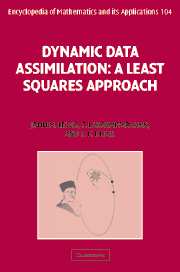Crossref Citations
This Book has been
cited by the following publications. This list is generated based on data provided by Crossref.
Lakshmivarahan, S.
Baldwin, Michael E.
and
Zheng, Tao
2006.
Further Analysis of Lorenz’s Maximum Simplification Equations.
Journal of the Atmospheric Sciences,
Vol. 63,
Issue. 11,
p.
2673.
Reddy, K. V.
Singh, Tarunraj
Cheng, Yang
and
Scott, Peter
2006.
Data Assimilation for Dispersion Models.
p.
1.
Oladunni, Olutayo O.
Trafalis, Theodore B.
and
Papavassiliou, Dimitrios V.
2006.
Computational Science – ICCS 2006.
Vol. 3991,
Issue. ,
p.
188.
Oladunni, O.O.
and
Trafalis, T.B.
2006.
A Pairwise Reduced Kernel-based Multi-classification Tikhonov Regularization Machine.
p.
130.
Kim, I. S.
Chandrasekar, J.
Palanthandalam-Madapusi, H. J.
Ridley, A. J.
and
Bernstein, D. S.
2007.
State Estimation for Large-Scale Systems Based on Reduced-Order Error-Covariance Propagation.
p.
5700.
Chandrasekar, J.
Ridley, A. J.
and
Bernstein, D. S.
2007.
A Comparison of the Extended and Unscented Kalman Filters for Discrete-Time Systems with Nondifferentiable Dynamics.
p.
4431.
Qin, Jun
Liu, Ronggao
Liang, Shunlin
Zhang, Hao
and
Hu, Bo
2007.
A new method based on remote sensing observations and data assimilation for estimation of evapotranspiration over field crops.
New Zealand Journal of Agricultural Research,
Vol. 50,
Issue. 5,
p.
997.
TSUYUKI, Tadashi
and
MIYOSHI, Takemasa
2007.
Recent Progress of Data Assimilation Methods in Meteorology.
Journal of the Meteorological Society of Japan. Ser. II,
Vol. 85B,
Issue. 0,
p.
331.
Haimberger, Leopold
2007.
Homogenization of Radiosonde Temperature Time Series Using Innovation Statistics.
Journal of Climate,
Vol. 20,
Issue. 7,
p.
1377.
Reddy, K. V. Umamaheswara
Yang Cheng
Tarunraj Singh
and
Scott, Peter D.
2007.
Data assimilation in variable dimension dispersion models using particle filters.
p.
1.
Oladunni, Olutayo O.
and
Trafalis, Theodore B.
2007.
Regularization Based Classification Models.
p.
25.
Qin, Jun
Liang, Shunlin
Liu, Ronggao
Zhang, Hao
and
Hu, Bo
2007.
A Weak-Constraint-Based Data Assimilation Scheme for Estimating Surface Turbulent Fluxes.
IEEE Geoscience and Remote Sensing Letters,
Vol. 4,
Issue. 4,
p.
649.
Yang Cheng
Reddy, K. V. Umamaheswara
Tarunraj Singh
and
Scott, Peter
2007.
CBRN data fusion using puff-based model and bar-reading sensor data.
p.
1.
Chandrasekar, J.
Kim, I. S.
and
Bernstein, D. S.
2007.
Reduced-order Kalman filtering for time-varying systems.
p.
6214.
Oladunni, Olutayo O.
and
Trafalis, Theodore B.
2007.
Computational Science – ICCS 2007.
Vol. 4487,
Issue. ,
p.
176.
Lawless, A. S.
Nichols, N. K.
Boess, C.
and
Bunse‐Gerstner, A.
2008.
Approximate Gauss–Newton methods for optimal state estimation using reduced‐order models.
International Journal for Numerical Methods in Fluids,
Vol. 56,
Issue. 8,
p.
1367.
Bannister, R. N.
2008.
A review of forecast error covariance statistics in atmospheric variational data assimilation. I: Characteristics and measurements of forecast error covariances.
Quarterly Journal of the Royal Meteorological Society,
Vol. 134,
Issue. 637,
p.
1951.
Daescu, Dacian N.
2008.
On the Sensitivity Equations of Four-Dimensional Variational (4D-Var) Data Assimilation.
Monthly Weather Review,
Vol. 136,
Issue. 8,
p.
3050.
Vukicevic, Tomislava
Jankov, Isidora
and
McGinley, John
2008.
Diagnosis and Optimization of Ensemble Forecasts.
Monthly Weather Review,
Vol. 136,
Issue. 3,
p.
1054.
Bennett, A. F.
Chua, B. S.
Pflaum, B. L.
Erwig, M.
Fu, Z.
Loft, R. D.
and
Muccino, J. C.
2008.
The Inverse Ocean Modeling System. Part I: Implementation.
Journal of Atmospheric and Oceanic Technology,
Vol. 25,
Issue. 9,
p.
1608.





